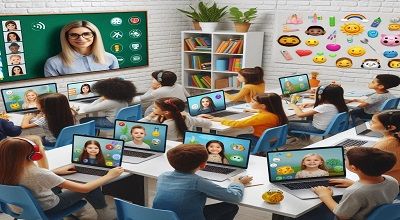Remote Education
Remote Education: The landscape of education has been undergoing a significant transformation, with remote education becoming increasingly popular. This trend, which accelerated during the COVID-19 pandemic, continues to evolve in 2024, driven by technological advancements, changing societal needs, and the growing acceptance of digital learning platforms. This article delves into the factors contributing to the rise of remote education, its benefits, challenges, and future prospects.
The Rise of Remote Education
Technological Advancements
One of the primary drivers of the growth in remote education is the rapid advancement in technology. High-speed internet, sophisticated learning management systems (LMS), and interactive tools like virtual reality (VR) and augmented reality (AR) have made online learning more engaging and accessible.
Changing Societal Needs
The modern lifestyle, characterized by flexibility and the need for work-life balance, has also played a crucial role in the popularity of remote education. Students and professionals alike seek the convenience of learning from anywhere, at any time, without the constraints of traditional classroom settings.
Pandemic Acceleration
The COVID-19 pandemic acted as a catalyst, pushing educational institutions to adopt online learning methods rapidly. This emergency response has since evolved into a more permanent shift as both institutions and students recognize the benefits of remote education.
Benefits of Remote Edu
Accessibility and Inclusivity
Remote edu breaks down geographical barriers, providing access to quality education for students in remote or underserved areas. It also supports inclusivity by offering flexible learning options for individuals with disabilities or those with demanding schedules.
Cost-Effectiveness
Online learning can be more cost-effective than traditional education. It reduces expenses related to commuting, housing, and physical materials. Moreover, many online courses and degrees are offered at a lower tuition rate compared to their on-campus counterparts.
Customizable Learning Experience
Students can tailor their learning experiences to suit their individual needs and preferences. With a wide range of courses available online, learners can choose subjects that interest them and proceed at their own pace, enhancing their overall educational experience.
Challenges of Remote Education
Digital Divide
Despite the benefits, remote edu also faces significant challenges. The digital divide, characterized by unequal access to technology and the internet, remains a critical issue. Students from low-income families or rural areas may struggle to participate fully in online learning.
Engagement and Motivation
Maintaining student engagement and motivation in a remote setting can be challenging. The lack of face-to-face interaction and the potential for distractions at home require innovative teaching strategies and self-discipline from students.
Quality and Accreditation
Ensuring the quality and accreditation of online courses is another challenge. Not all online programs meet the same standards as traditional institutions, making it essential for students to verify the credibility and recognition of their chosen courses.
Future Prospects
Hybrid Learning Models
The future of education is likely to see a blend of traditional and remote learning, known as hybrid learning. This model combines the best of both worlds, offering flexibility while maintaining the benefits of in-person interaction and hands-on experiences.
Lifelong Learning
With the rapid pace of technological change and evolving job markets, lifelong learning is becoming increasingly important. Remote edu provides a convenient way for professionals to continuously update their skills and knowledge throughout their careers.
Global Collaboration
Remote edu facilitates global collaboration and exchange of ideas. Students can participate in international programs, work on projects with peers from different countries, and gain a broader perspective on their fields of study.
Conclusion
The rise of remote education in 2024 signifies a transformative shift in the way we approach learning. While it presents numerous benefits, it also poses challenges that need to be addressed to ensure equitable and high-quality education for all. As technology continues to advance and society adapts, remote edu is poised to play a pivotal role in the future of learning.
FAQs
1. What is remote education?
Remote edu, also known as online or distance learning, refers to the delivery of educational content and instruction through digital platforms, allowing students to learn from anywhere with an internet connection.
2. How has the pandemic influenced remote education?
The COVID-19 pandemic accelerated the adoption of remote edu as institutions worldwide had to quickly shift to online learning to continue providing education during lockdowns and social distancing measures.
3. What are the benefits of remote edu?
Remote education offers accessibility, cost-effectiveness, and customizable learning experiences. It allows students to learn at their own pace, access education from anywhere, and reduce costs related to commuting and housing.
4. What are the main challenges of remote edu?
Challenges include the digital divide, maintaining student engagement and motivation, and ensuring the quality and accreditation of online courses.
5. How does remote edu address accessibility?
Remote education provides access to quality education for students in remote or underserved areas, supports inclusivity for individuals with disabilities, and offers flexible learning options for those with demanding schedules.
6. What is the digital divide in remote edu?
The digital divide refers to the gap between individuals who have access to technology and the internet and those who do not, which can hinder participation in remote edu for some students.
7. What is hybrid learning?
Hybrid learning is a model that combines traditional in-person education with remote learning, offering flexibility while maintaining the benefits of face-to-face interaction and hands-on experiences.
8. How can students verify the quality of online courses?
Students should check the accreditation and credibility of online programs, look for reviews and ratings, and ensure that the courses are recognized by reputable educational institutions and industry bodies.
9. What is the future of remote education?
The future of remote education includes the growth of hybrid learning models, increased emphasis on lifelong learning, and enhanced global collaboration, providing more opportunities for students worldwide.
